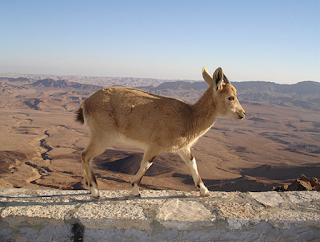Q: Can you describe this stakeholder in 200-250 words?
Alberto Fernandez-Arias is a Spanish wildlife veterinarian. He
was one of the leaders of a team of scientists that successfully cloned an
extinct animal: the Bucardo. The kid only lived for a short while (minutes)
before her lungs gave out and she died. Dr. Fernandez-Arias is from Spain but
is bilingual and can speak English as you can see in his TED talk about their
de-extinction. His English, although very intelligent, is very rough. He is a
little difficult to understand but with context clues and paying attention he
is understandable. Dr. Fernandez-Arias is a middle aged man with hazel colored
eyes. He also has a receding hairline that looks almost like a reverse Mohawk.
Aside from his lab coat and expedition clothing, he dresses well in slacks and
tuxedo jackets. He does not speak with his hands like most people do. He seems
to be a typical scientists that is a little reserved. His speech is very factual,
abrupt, and to the point. In front of a crowd, although he is obviously
passionate about his work, he seems to not want to be there. Rather he would
like to present his work and be done than elaborate on every detail. This could
be because his first language is not English and he was uncomfortable speaking
it in front of a crowd.
"[the bridging technique] was a tremendous success" 7:20
"[On Jul y 30th, 2003] we obtained, by cesarean-section, a live Bucardo female kid. It was the first de-extinction." 10:20
"[the cage trap] is the best method for capture of the Spanish Mountain Ungulates." 4:13
Q: Can you explain how valid these claims are? Objectively, how much weight do these claims carry? How credible are they?
Dr. Fernandez-Arias's claims are very credible. He is the one that did all of this research and experimentation so he did not have to go through middle-men to try and get straight facts. Instead he was there and can tell the story / facts from a first hand account. Also he is a wildlife veterinarian. He received his Doctor in Veterinary Science from Complutense University in Madrid. He also wrote his PhD thesis on “Reproductive characteristics and embryo transfer in the Spanish ibex (Capra pyrenaica hispanica)” in 1996.
Q: Can you explain how these claims are similar and/or different to the other stakeholders?
Dr. Fernandez-Arias has view points in common with other doctors involved in this specific de-extinction attempt and also other scientists and doctors that are trying to revive other species like mammoths. They all have the same goal of bringing extinct species back to life. All doctors and scientists that this was the first "successful" attempt at de-extinction. Also doctors of all types will agree that the less stressed something is the better chance it has on recovering or in this case donating usable cells to recreate.
Dr. Fernandez-Arias would have opposing view points with people who are against cloning. De-extinction is basically cloning just more specific with an extinct species being involved instead of one in our ecosystem today. People and even some scientists question whether or not bringing back an extinct species will harm our environment and what the risks of de-extinction are.
Dr. Fernandez-Arias's claims are very credible. He is the one that did all of this research and experimentation so he did not have to go through middle-men to try and get straight facts. Instead he was there and can tell the story / facts from a first hand account. Also he is a wildlife veterinarian. He received his Doctor in Veterinary Science from Complutense University in Madrid. He also wrote his PhD thesis on “Reproductive characteristics and embryo transfer in the Spanish ibex (Capra pyrenaica hispanica)” in 1996.
Q: Can you explain how these claims are similar and/or different to the other stakeholders?
Dr. Fernandez-Arias has view points in common with other doctors involved in this specific de-extinction attempt and also other scientists and doctors that are trying to revive other species like mammoths. They all have the same goal of bringing extinct species back to life. All doctors and scientists that this was the first "successful" attempt at de-extinction. Also doctors of all types will agree that the less stressed something is the better chance it has on recovering or in this case donating usable cells to recreate.
Dr. Fernandez-Arias would have opposing view points with people who are against cloning. De-extinction is basically cloning just more specific with an extinct species being involved instead of one in our ecosystem today. People and even some scientists question whether or not bringing back an extinct species will harm our environment and what the risks of de-extinction are.
Apfel X. "dsc07575" 01/14/2008 via flickr. Attribution-ShareAlike 2.0 Generic

No comments:
Post a Comment